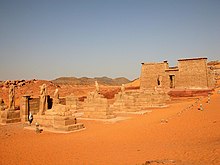
Back وادي السبوع Arabic وادى السبوع ARZ Wadi al-Sabua Catalan Wadi as-Subu' German Uadi es-Sebua Spanish Ouadi es-Seboua French Uadi es-Sebua Galician Vádi esz-Szebua Hungarian Uádi Sebua Portuguese Wadi es-Sebua Swedish
| UNESCO World Heritage Site | |
|---|---|
 A picture of Wadi es-Sebua temple | |
| Location | New Wadi es-Sebua, Egypt |
| Part of | Nubian Monuments from Abu Simbel to Philae |
| Criteria | Cultural: (i)(iii)(vi) |
| Reference | 88 |
| Inscription | 1979 (3rd Session) |
The temples of Wadi es-Sebua (Arabic: وادى السبوع, so-called because of the sphinx-lined approach to the temple forecourts), is a pair of New Kingdom Egyptian temples, including one speos temple constructed by the 19th Dynasty Pharaoh Ramesses II, in Lower Nubia.[1]

As part of the International Campaign to Save the Monuments of Nubia, along with Abu Simbel, Philae, Amada, and other Nubian archaeological sites, the temples at Wadi es-Sebua were relocated in the 1960s and inscribed on the UNESCO World Heritage List in 1979.[2]
- ^ Wilkinson, Richard H. (2003). The Complete Temples of Ancient Egypt. Thames & Hudson. p. 220
- ^ "Nubian Monuments from Abu Simbel to Philae". UNESCO World Heritage Centre. United Nations Educational, Scientific, and Cultural Organization. Retrieved 7 September 2021.